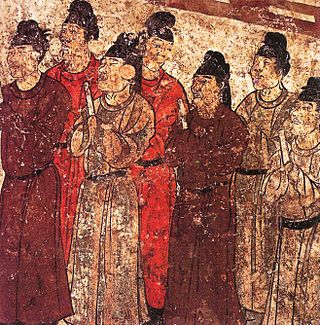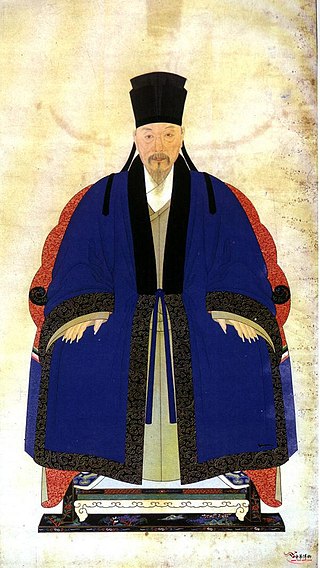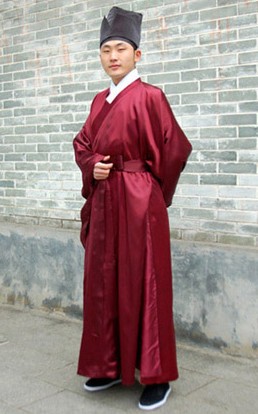
Clogs are a type of footwear made in part or completely from wood. Used in many parts of the world, their forms can vary by culture, but often remained unchanged for centuries within a culture.

Geta (下駄) are traditional Japanese footwear resembling flip-flops. A kind of sandal, geta have a flat wooden base elevated with up to three "teeth", held on the foot with a fabric thong, which keeps the foot raised above the ground.

Futou, also known as fu (幞) and toujin (頭巾), was one of the most important forms of Chinese headwear in ancient China with a history of more than one thousand years. The futou first appeared in Northern Zhou under the reign of Emperor Wu where it became prevalent. It was also commonly worn in the Tang and Song dynasties. The futou was typically worn by government officials. The futou was originally turban-like headwear which was tied at the back of its wearer's head, with the two corners going to opposite directions and acting as decorations. From the Sui to the Ming dynasties, the futou evolved and was developed based on the fujin. The futou eventually came to assume a variety of shapes and styles. The shape of the futou worn by the government officials in the Song and Ming dynasties was based on the futou of the Tang dynasty which was its precursor.

Chinese clothing includes the traditional hanfu and garments of ethnic minorities, as well as modern variations of indigenous Chinese dresses. Chinese clothing has been shaped through its dynastic traditions, as well as through foreign influences. Chinese clothing showcases the traditional fashion sensibilities of Chinese culture traditions and forms one of the major cultural facets of Chinese civilization.

Beizi, also known as beizi and chuozi, is an item worn in traditional Chinese attire common to both men and women; it is typically a large loose outer coat with loose and long sleeves. It was most popular during the Song dynasty, Ming dynasty, and from the early Qing to the Mid-Qing dynasty. The beizi originated in the Song dynasty. In the Ming dynasty, the beizi was referred as pifeng. When worn by men, it is sometimes referred as changyi, hechang, or dachang when it features large sleeves and knotted ties at the front as a garment closure.
Banbi, also known as banxiu and sometimes referred as beizi or half-beizi before the term beizi eventually came to refer to a long-sleeved beizi in the Song dynasty, and referred as dahu in the Yuan dynasty, is an upper garment item in Hanfu. The banbi is in the form of a waistcoat or outerwear with short sleeves, which could either be worn over or under a long-sleeved ruqun. The style of its collar varies; it can also be secured at the front either with ties or a metal button.
A yuanlingshan is a type of round-collared upper garment in the traditional Chinese style of clothing known as Hanfu; it is also referred to as a yuanlingpao or a panlingpao when used as a robe. The yuanlingshan and yuanlingpao were both developed under the influence of ancient Chinese clothing, known as Hufu, originating from the Donghu people during the early Han dynasty and later by the Wuhu, including the Xianbei people, during the Six Dynasties period. The yuanlingpao is an article of formal attire primarily worn by men, although in certain dynasties, such as the Tang dynasty, it was also fashionable for women to wear. In the Tang dynasty, the yuanlingpao could be transformed into the fanlingpao using buttons.

Daopao, also known as xuezi when used as a Xifu during Chinese opera performances, and deluo when it is blue in colour, is a traditional form of paofu in Hanfu and is also one of the most distinctive form of traditional clothing for the Han Chinese. The daopao was one of the most common traditional form of outer robe worn by men. Daopao literally means "Taoist robe"; however, despite its name, the daopao were and is worn by men, and did not imply that its wearer had some affiliation to taoism. The daopao can be dated back to at least the Ming dynasty but had actually been worn since the Song dynasty. Initially the daopao was a form of casual clothing which was worn by the middle or lower class in the Ming dynasty. In the middle and late Ming, it was one of the most common form of robes worn by men as casual clothing. The daopao was also a popular formal wear by the Ming dynasty scholars in their daily lives. It was also the daily clothing for the literati scholars in the Ming dynasty. In the late Ming, it was also a popular form of clothing among the external officials and eunuchs sometimes wore it. The daopao was also introduced in Korea during the Joseon period, where it became known as dopo and was eventually localized in its current form.

In China, women had different kinds of clothes in ancient times. Those clothes changed with the dynasty. For examples, in the 1920s, the Cheongsam was fashionable among socialites and upperclass women; during the 1960s, very austere clothing styles were prevalent; today, a wide variety of fashions are worn. Different provinces and regions of China also have different clothing styles.

Hanfu are the traditional styles of clothing worn by the Han Chinese. There are several representative styles of hanfu, such as the ruqun, the aoqun, the beizi and the shenyi, and the shanku.

Mianfu is a kind of Chinese clothing in hanfu; it was worn by emperors, kings, and princes, and in some instances by the nobles in historical China from the Shang to the Ming dynasty. The mianfu is the highest level of formal dress worn by Chinese monarchs and the ruling families in special ceremonial events such as coronation, morning audience, ancestral rites, worship, new year's audience and other ceremonial activities. There were various forms of mianfu, and the mianfu also had its own system of attire called the mianfu system which was developed back in the Western Zhou dynasty. The mianfu was used by every dynasty from Zhou dynasty onward until the collapse of the Ming dynasty. The Twelve Ornaments were used on the traditional imperial robes in China, including on the mianfu. These Twelve Ornaments were later adopted in clothing of other ethnic groups; for examples, the Khitan and the Jurchen rulers adopted the Twelve ornaments in 946 AD and in 1140 AD respectively. The Korean kings have also adopted clothing embellished with nine out of the Twelve ornaments since 1065 AD after the Liao emperor had bestowed a nine-symbol robe to the Korean king, King Munjong, in 1043 AD where it became known as gujangbok.

Zaju chuishao fu, also called Guiyi, and sometimes referred as "Swallow-tailed Hems and Flying Ribbons clothing" or "swallow tail" clothing for short in English, is a form of set of attire in hanfu which was worn by Chinese women. The zaju chuishao fu can be traced back to the pre-Han period and appears to have originated the sandi of the Zhou dynasty; it then became popular during the Han, Cao Wei, Jin and Northern and Southern dynasties. It was a common form of aristocratic costumes in the Han and Wei dynasties and was also a style of formal attire for elite women. The zaju chuishao fu can be further divided into two categories of clothing style based on its cut and construction: the guipao, and the guichang.

Qixiong ruqun, which can also be referred as Qixiong shanqun, also known as "chest-high ruqun", is a set of attire in hanfu, the traditional Chinese clothing worn by the Han Chinese. The qixiong ruqun is a unique style of ruqun, which is characterized with a high waistline qun, Chinese skirt. The qun used in the qixiong ruqun is generally tied above the bust level. It was worn by women during the Southern dynasties, Sui dynasty, Tang dynasty and Five Dynasties and Ten Kingdoms period. The style was also revived in the early and middle Ming dynasty.
Hanfu accessories refers to the various form of fashion accessories and self-adornments used and worn with hanfu throughout Chinese history. Hanfu consists of many forms of miscellaneous accessories, such as jewelries, yaopei, ribbons, shawls, scarves, and hand-held accessories, etc.

Feiyufu, also called feiyu mangyi, is a type of traditional Han Chinese clothing which first appeared in the Ming dynasty. It is also specific name which generally refers to a robe decorated with the patterns of flying fish. The feiyufu worn by the Ming dynasty imperial guards reappeared in the 21st century following the hanfu movement and is worn by Hanfu enthusiasts of both genders.

Tongtianguanfu is a form of court attire in hanfu which was worn by the Emperor during the Song dynasty on very important occasions, such as grand court sessions and during major title-granting ceremonies. The attire traces its origin from the Han Dynasty.It was also worn in the Jin dynasty Emperors when the apparel system of the Song dynasty was imitated and formed their own carriages and apparel system, and in the Ming dynasty. The tongtianguanfu was composed of a red outer robe, a white inner robe, a bixi, and a guan called tongtianguan, and a neck accessory called fangxin quling.

Qizhuang, also known as Manfu and commonly inappropriately referred as Manchu clothing in English, is the traditional clothing of the Manchu people. Qizhuang in the broad sense refers to the clothing system of the Manchu people, which includes their whole system of attire used for different occasions with varying degrees of formality. The term qizhuang can also be used to refer to a type of informal dress worn by Manchu women known as chenyi, which is a one-piece long robe with no slits on either sides. In the Manchu tradition, the outerwear of both men and women includes a full-length robe with a jacket or a vest while short coats and trousers are worn as inner garments.

Daojiao fushi, also known as Taoist clothing, are religious clothing and adornment worn by devotees and practitioners of Taoism, an indigenous religion and life philosophy in China. Chinese culture attaches great importance to "cap and gown" are seen as important signs of levels of etiquettes; it is also a visible marker of the Taoist identity. Taoist ritual garments (sometimes referred as daoyi are forms of ritual clothing. These clothing worn by the Taoist priests are inherited from the Han Chinese traditional clothing and holds clear Taoist cultural meaning. When performing rituals and important rituals, Taoist priests wear ceremonial attires which appear to be aligned with elements of Chinese cosmology; these ceremonial attires are therefore strong spiritual intermediaries acting on the part of the Taoist devotees community. Different forms of clothing will be worn by Taoist priests in accordance to ritual types and obvious distinctions are found in the attire of Taoist priests based on their different positions to the altar. There were also codes which would stipulate the appropriate Taoist attire to be worn during both ritual performance and when being off duty.
After the Jin dynasty was founded, the Jin dynasty rulers imitated the Song dynasty and decided to establish their own carriages and apparel system.
































